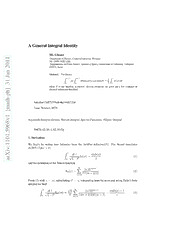
A General Integral Identity PDF
Preview A General Integral Identity
A General Integral Identity MLGlasser 1 DepartmentofPhysics,ClarksonUniversity,Potsdam 1 NY13699-5820,USA 0 DepartamentodeF´ısicaTeo´rica,Ato´micayO´ptica,UniversidaddeValladolid,Valladolid 2 470071,Spain n a Abstract. Theidentity J π/2 π/2 π 1 1 dφ dθsinφF(xsinφsinθ)= F(xt)dt 3 Z0 Z0 2 Z0 where F is any function, is derived. Several extensions are given and a few examples of ] physicalinterestaredescribed. h p - h t 6accdae13eff7i3l9n4o4qrr4s8t12ux a m IsaacNewton,1676 [ 1 v Keywords:Integralidentity,Watsonintegral,SpecialFunctions,Ellipticintegral 8 6 9 5 PACS:02.30.-f,02.30.Gp . 1 0 1. Derivation 1 1 We begin by noting two formulas from the familiar reference[1]: The Bessel transform : v (6.567(13))(x>0) i X 1 dtt sinh(x) r I0(xt)= (1) a 0 √1 t2 x Z − andthedefinitionoftheStruvefunction L0(z)= ∞ Γ(2z(/m2)+2m3+/12). (2) m=0 X From(2)withz = xt, substitutingt2 = u, integratingterm-by-termandusingEuler’sbeta integralwefind 1 dtt L0(xt)= √π ∞ (x/2)2m+1 = cosh(x)−1. (3) Z0 √1−t2 2 mX=0Γ(m+3/2)Γ(m+2) x AGeneralIntegralIdentity 2 Consequently, 1 dtt 1 e x 1 [I0(xt) L0(xt)]= − − = e−xtdt. (4) Z0 √1−t2 − x Z0 However[2], 1 π dt [I0(z) L0(z)]= e−zt. (5) 2 − Z0 √1−t2 Therefore, 1 udu 1 dt π 1 e xut = e xtdt (6) − − Z0 √1−u2 Z0 √1−t2 2 Z0 whichcanbewritten π/2 π/2 π x dφ dθsinφe xsinφsinθ = e tdt. (7) − − 2x Z0 Z0 Z0 Next,letF belongtotheclassoffunctionswhichareLaplacetransforms,i.e. forsome realf F(s)= ∞e stf(t)dt (8) − Z0 Now,in(7)replacexbyxu,multiplybothsidesbysuchanf(u)andintegratebothsideswith respecttouover[0, ],withthefurtherrestriction(onf)thattheorderofintegrationcanbe ∞ freelyinterchanged.Theresultis π/2 π/2 π x dφ dθsinφF(xsinφsinθ) F(t)dt=0. (9) − 2x 0 0 0 Z Z Z The left hand side of (9) is a linear functionalon an ideal of the class of all real integrable functions. TheHahn-Banachlemma[3]assuresthat(9)canbeextended,atleasttotheclass ofallpiecewisecontinuousreal-valuedfunctionsonthepositiverealline. Sincexisafreeparameter,letusreplacexbyxsinβ andintegrateoverβ toget π/2 π/2 π/2 π π/2 dβ xsinβ dβ dφ dθsinφF[xsinβsinφsinθ]= dtF[t]. 2x sinβ 0 0 0 0 0 Z Z Z Z Z (10) Byintegratingtherighthandsideof(10)byparts,followedbythesubstitutionu=cosβ we havetheintriguingidentity 1 1 1 ududvdw F(xuvw)= Z0 Z0 Z0 (1−u2)(1−v2)(1−w2) p π 1 1+√1 u2 duln − F(xu). (11) 4 0 1 √1 u2! Z − − Clearly, this process can be repeated to obtain a reduction formula for an n fold multiple − integral,n=4,5,6,...,toatmostan(n 2)-foldintegral. − It seemed unlikely that such a general and useful identity as (9) has no precedents in the classical mathematicalliterature; a bit of searchingshowed that such a connectiondoes AGeneralIntegralIdentity 3 exist. Let us set F(x) = f (x). and note that the second term on the left hand side of (9) ′ is formally [f(x) f(0)]/x. Next write h(x) = f(0)+x π/2dφsinφf (xsinφ), so (9) − 0 ′ can be expressedf(x) = (2/π) π/2h(xsinθ)dθ, which is preciselySchlo¨milch’sintegral 0 R equation[4]. Thus it is possible that Schlo¨milch, or Abel, since his eponymousequation is R equivalenttoSchlo¨milch’s,wasawareofsomeformof(9). Itisreasonable,therefore,toseekamoreformalderivationof(9)thatdoesnotrelyon manipulatingspecificfunctions.Thefollowingargumentplacesitinprincipleamongafamily ofsuchidentitiesanddisplaysitselementarycharacter.Considerthedoubleintegral 1 1 f(x+y)F(xy) S = dx dy . (12) 0 0 (1 x2)(1 y2) Z Z − − wheref andF arearbitrary.Thechangeofvapriables 1 x= [u+ u2 4v] 2 − p 1 y = [u u2 4v] (13) 2 − − havingJacobian(u2 4v) 1/2leadsto p − − 1 v+1 f(u) S =2 dvF(v) dv . (14) Z0 Z2√v (u2−4v)[(1+v)2−u2] Now let f(x) = x. The u integral is π/2 ypielding (9) after a trigonometric substitution. − Everychoiceoff givesapossiblynewintegralidentity.Forexampletakef(x)=1. Since 1+v du 1 1 v = K − , (15) Z2√v (u2−4v)([(1+v)2−u2] v+1 (cid:18)1+v(cid:19) afteranelementarychanpgeofintegrationvariable,(12)becomes 1 dt 1 t 1 π/2 π/2 K(t)F − = dθ dφF(sinθsinφ). (16) 1+t 1+t 2 Z0 (cid:18) (cid:19) Z0 Z0 Asanapplicationof(16),considerthefamilyofintegrals 1 K(k) K = dk (17) n (1+k)n 0 Z ofwhichonlythemembersn=0,1appeartobewell-known[1,7].First,withF(x)=1we getimmediatelyK1 = π2/8. Now,bysettingF(x) = xn,writing1 k = 2 (1+k)and − − employingthebinomialseries,wefindtherecursionrelation Kn+1 = 2nπ+3 "ΓΓ22(cid:0)nn++2221(cid:1) −(−1)nπ#−nk=−11(−1)k(cid:18) nk (cid:19)2−kKn+1−k (18) X (cid:0) (cid:1) n=1,2,3,... An interesting formularesults from selecting F in such a way as to cancel the elliptic integralin(16): π/2 π/2 1 dθ dφ =2ln(2). (19) Z0 Z0 K 11−+ssiinnθθssiinnφφ (cid:16) (cid:17) AGeneralIntegralIdentity 4 OtherExamples InarecentstudyofFeynmandiagramsintwo-dimensionalquantumfieldtheories[5]and related work[6]attention was drawn to variousmomentsof powersof the complete elliptic integralof the firstkindK(k). A numberofthese were evaluatedandthe valuesof several others were conjectured. The form of (9) strongly suggests that it may prove usefulin this connection.Forexample,wehave[7] π/2 1 √1 a2 K(asinθ)dθ =K2 − − (20) s 2 0 Z 1 π K(xt)dt= 3F2(1/2,1/2,1/2;1,3/2;x2). (21) 4 Z0 Therefore,bysettingF =Kin(9),weobtain 1 udu 1 √1 x2u2 π2 K2 − − = 3F2(1/2,1/2,1/2;1,3/2;x2) (22) 0 √1 u2 s 2 4 Z − andforx=1,aftersomesimplification, 1/√2 1 kK2(k)dk = πG (23) 4 Z0 whereGisCatalan’sconstant.Both(22)and(23)appeartobenewandthereisevidencethat (23)istheonlyanalyticallytractablemomentofK2overasub-unitinterval[8]. Inthesamevein,letussetF(t)=1/√1 t2in(11)withx=1. Thisresultsin − 1 1 1 ududvdw =πG. (24) Z0 Z0 Z0 (1−u2)(1−v2)(1−w2)(1−u2v2w2) An obvious application ofp(11) and its higher dimensional generalizations is to so-called Watson integrals [9], which are integrals over a polytope of a ratio of trigonometric polynomials.Thus,(11)givesimmediately π/2 π/2 π/2 sinβ dβdφdθ = 1 xsinβsinφsinθ 0 0 0 Z Z Z − π 3π2 ArcCos2(x) 2πArcCos(x)+ (25) 4x − 4 (cid:20) (cid:21) Analternativeformof(16)is 1 π/2 π/2 dθdφ 1 sinθsinφ K(u)f(u)du= f − . (26) 1+sinθsinφ 1+sinθsinφ Z0 Z0 Z0 (cid:18) (cid:19) Reference[7]containsover100integralshavingtheformofthelefthandsideof(26)allowing many,apparentlynew,doubletrigonometricintegralstobefound.Forexample, π/2 π/2 dθdφ =4kK(k)K′(k), (27) 0 0 sinθsinφ(1+sinθsinφ) Z Z where k = √2 1. With pjudicious selection of rational functions F many striking, and − potentiallyuseful,resultscanbeworkedoutinthisarea,whichwillbethesubjectofafuture report. AGeneralIntegralIdentity 5 Acknowledgements The author thanks Prof. L.M. Nieto and the Physics Department of the University of Valladolidfortheirhospitalitywhilethisworkwascarriedout. AGeneralIntegralIdentity 6 References [1]I.S.GradshteynandI.M.Ryzhik,TableofIntegrals,SeriesandProducts[AcademicPress, NY1963] [2]TablesofIntegralTransformsIEd. A.Erde´lyi,[McGraw-HillBookCompany,NewYork, 1954]Eq4.3(12) [3]L.H.Loomis,AnIntroductiontoAbstractHarmonicAnalysis,[D.VanNostrand,Inc.New York,1953] [4] E.T. Whittaker and G.N. Watson, A course in Modern Analysis,CambridgeUniv. Press, 1927]Chap.11. [5]DavidH.Baileyetal,J.Phys.A41,205203(2008) [6]D.Borweinetal.,MomentsofRamanujan’sGeneralizedEllipticIntegrals(Unpublished) [7]M.L.Glasser,J.Res. oftheNBS80B,207(1976). [8]Dr. JamesWan(Privatecommunication). [9]A.J.Guttmann,J.Phys.A42,232001(2009).
